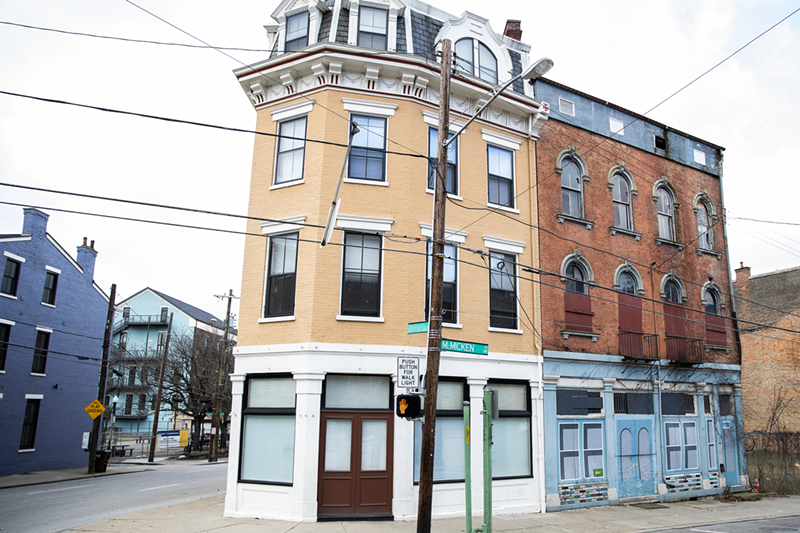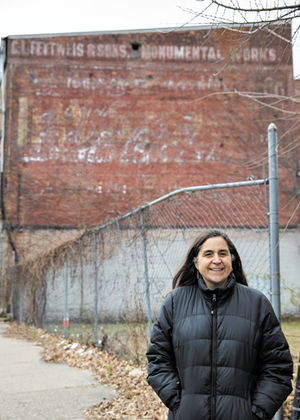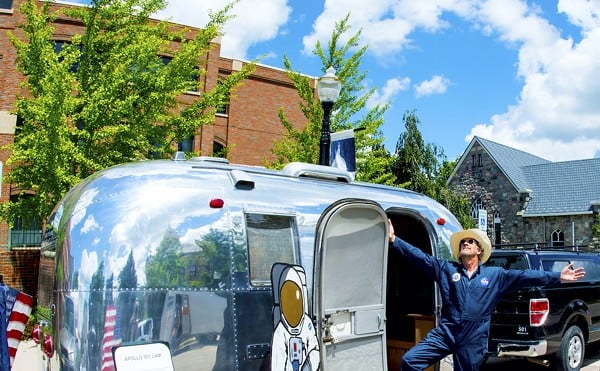
The long-planned Over-the-Rhine Museum — inspired by New York City’s popular Lower East Side Tenement Museum — has taken a major step toward becoming reality.
On Tuesday night, while presenting the Cincinnati History Lecture at Mercantile Library’s annual meeting, Anne Delano Steinert announced the nonprofit museum — for which she serves as board chairman — has acquired a site near Findlay Market. She is also a historian and preservationist, pursuing a doctorate in urban history at the University of Cincinnati.
The museum site is a currently vacant two-building complex, with about 4,600-square-feet of total space, at 3 W. McMicken Ave. and 12 Findlay St. The two separate buildings — one a single-family home; the other multistory and tenement-style — back up to each other and have a shared connecting structure.
The nonprofit OTR A.D.O.P.T. had purchased the complex from an owner who was considering rehabbing it and later agreed to sell the buildings to the fledgling museum.
The museum has already paid $10,000 to OTR A.D.O.P.T. and then used a $25,000 grant from the Carol Ann and Ralph V. Haile, Jr./U.S. Bank Foundation and the foundation’s promise of a like amount in 2019 to make the first of three approximately $50,000 payments on the property. The museum has until December of this year to finish the $165,000 purchase.
“This is a huge milestone, but it doesn’t mean it’s done,” Steinert says of the site acquisition. “To bring this amazing cultural resource to life, we still need help.”
Steinert cautions that completing the purchase would not mean the museum could immediately open. She estimates it would take a total of $2.4 million to do everything necessary — structural repairs, usable bathrooms, office and event space, a gift shop and painstaking assembly of period-accurate recreations of living quarters. She thinks the museum could interpret the stories of up to six families.
Steinert and the museum’s board members and volunteers have identified 131 families — at least 235 individuals — who have lived at the addresses over the years. As Over-the-Rhine’s fortunes declined in the later decades of the 20th century, the stories can be wrenching. For instance, one recounts a woman with children who lived in an attic room with just a mattress on the floor.
“We’re going to try to get a grant to convene national museum and history experts, give them what we know about these people and the spaces, and let them figure out what they think the brightest moments are,” Steinert says.
There are two main families — and future museum focuses — that comprise the complex’s history. The first were German immigrants C.L. and Anna Fettweis, who emigrated here in the 1840s and bought the single-family residence in 1860.
Sometime in the 1870s, they built the brick tenement on McMicken, taking out a mortgage for $1,000 from the Ancient Order of the Druids, a benevolent society. The family operated a marble monument business on the McMicken building’s first floor storefront; a hand-painted “ghost sign” for the business still remains visible on the building’s side.
The second family was Solomon and Rebecca Kabakoff, Russian Jewish immigrants who came to Cincinnati and purchased the complex in the late 1920s from the Fettweises, who had already moved out. They then added the connecting building, already having established a dry goods store in Over-the-Rhine.
“The family moved in and had a dry good store on the first floor (of the McMicken building), run by Rebecca,” Steinert says. “The father was a tailor and furrier, and according to the grandsons I talked to wasn’t particularly involved in running the shop.”
Most of the building, she continues, was used for their family. They rented out the Findlay Street building to other tenants, and eventually rented out more of the McMicken building as their children moved out.
The family sold the complex in the 1950s. From then on, ownership patterns were less long-term.
“The house went through maybe six to seven landlords from the early ’50s,” Steinert says.
Steinert has developed a plan to begin turning the site into a museum in incremental phases. The first would be to create a multi-use space in the McMicken storefront and use that as a base for area walking tours. Those will start this summer, thanks to a grant from Ohio Humanities, depending on whether or not the interior space is usable.
Next would come restoration of the exterior storefront to the way it was when it was used by the Kabakoffs, though the interior wouldn’t yet be a recreation of the dry goods store.
“The hope would be to open that sometime in 2020, and once we have that kind of physical presence, people can come and see the potential,” Steinert says.
The purpose of such a house museum, as opposed to the more traditional ones that are homes of the city’s most illustrious and powerful citizens, is to bring a city’s history to life — especially the stories of those who lived in its oldest neighborhoods — by recreating the everday and often-challenging circumstances in a city’s historic, densely urban neighborhoods.
In Over-the-Rhine, like in New York’s Lower East Side, that also can mean telling the story of immigrants coming to America — such museums, in their way, can be seen as more vernacular extensions of the Statue of Liberty.
“This is a museum where you immerse yourself in the past and allow yourself to be transported,” Steinert says. “It’s almost time-travel really. The idea is that as you experience that, you build empathy and compassion.
“So many of the things we struggle with today — poverty, immigration, xenophobia — are old problems. You may look at poor people today, but in fact your ancestors three generations ago were in the same spot. If you know that, you’ll be able to build a better, more inclusive future for Over-the-Rhine, Cincinnati, the whole country.”
For more information on the Over-the-Rhine Museum, visit otrmuseum.org.
This article has been updated to correct the name of OTR A.D.O.P.T.






